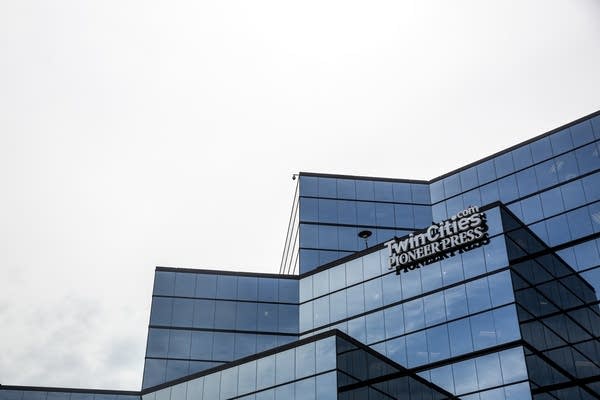Twin Cities provides a tale of newspaper woe and redemption

Go Deeper.
Create an account or log in to save stories.
Like this?
Thanks for liking this story! We have added it to a list of your favorite stories.
For a seminar in the travails of American newspapers, head to the Twin Cities.
It's a tale of two newspapers in a region where residents retain an affinity for daily newspapers, even though trust in media nationally is at an all-time low amid cries of fake news and bias.
The Twin Cities metro region retains two daily newspapers: One, a media darling owned by Minnesota billionaire who has invested in the paper; the other, owned by a New York hedge fund that industry watchers contend is more interested in reaping profit than retaining reporters.

"More journalism is good for a community," said Rene Sanchez, editor and senior vice president at the Star Tribune.
Turn Up Your Support
MPR News helps you turn down the noise and build shared understanding. Turn up your support for this public resource and keep trusted journalism accessible to all.
"You really can't fake your way there," he said. "Readers are smart: they know when content is thin, when you're not where you're supposed to be."
Journalists to hedge fund owner: Sell or invest
Nearly a decade ago, Sanchez's paper, the state's largest, was in the middle of bankruptcy and was emblematic of newspaper industry woes.

Today, it's the smaller, scrappier newspaper, the Pioneer Press, and its owner Alden Global Capital that are making headlines across the nation.
"We're grateful that we're able to say that while it's not all rainbows and roses, we're in a great position," said Neal Justin, a TV and radio critic for the paper who serves as a co-chair of the Star Tribune unit of the Minnesota Newspaper Guild and Typographical Union. "I think we're one of the best in the country, just nine years after [the bankruptcy]."
The Guild represents more than 250 employees at the Star Tribune and City Pages.
Justin hopes the Star Tribune story stands as a note of optimism for those at the Pioneer Press. Even though the Pioneer Press is showing a profit on paper, posting a 13 percent profit margin last fiscal year, the headcount of the newsroom has been sliced in half during Alden's ownership.

Alden is a New-York based hedge fund started in 2007 by Randall Smith. Smith named Heath Freeman, a 37-year-old hedge fund manager as its president. In 2010, Alden acquired MediaNews Group Inc. out of debt. MediaNews Group owned the Salt Lake City Tribune, the Denver Post and the Pioneer Press. Alden now owns about 100 newspapers across the nation. MediaNews Group is now known as Digital First Media.
Through its union, Pioneer Press journalists have called on Alden to either invest more money in staffing or sell the paper. They've bought ads in the rival Star Tribune, seeking another owner for the newspaper that traces its history back to the Minnesota Pioneer, the first daily newspaper in what would later become the state of Minnesota.
Calls to Alden were not returned. The company's website has no links or information other than a landing page with a company logo and an image of a forest.
This all boiled over in early May when journalists from several Alden-owned newspapers, including the Pioneer Press, protested outside the company's New York City headquarters. Staff and the editorial board of the Denver Post have led the charge, with biting editorials about the effects of Alden's ownership. A recent headline in the Daily Beast read: "The Denver Post Is In Full On Rebellion Against Its Hedge Fund Master."

The protests have made headlines in the Washington Post and have been written about extensively by journalist trade organizations.
The issue is not just an internal newsroom issue. Journalists and media watchers warn that Alden's ownership is decimating the Fourth Estate, often seen as the eyes and ears of the public and the institution that keeps public officials accountable. That, some argue, is a threat to democracy.
"What Alden is doing is basically sending us on a path, sooner or later, to oblivion," noted reporter Dave Orrick, the head of the union representing Pioneer Press journalists, in a recent MPR News interview. "They're milking us dry by taking the profits out of the company and not investing it back in the newsroom, and that's not necessary."
Orrick noted he and others have been having "quiet conversations" with people who might buy the paper.
He declined to name those people, quipping he has more confidential sources on this matter than as a reporter covering Minnesota politics.
Look west?

The paper need only look to the west for a glimmer of hope.
Five years after the Star Tribune emerged from bankruptcy, Minnesota billionaire Glen Taylor bought the paper for a reported $100 million in July 2014. Taylor owns the Minnesota Timberwolves and Lynx basketball teams. In late 2016, Taylor told City Pages, which he also owns, that he'd be interested in buying the Pioneer Press but wasn't sure it would pass antitrust muster with the U.S. Department of Justice.
"The difficulties in newspaper economics don't produce a lot of potential buyers," he said.
In the time since bankruptcy, the Star Tribune has won two Pulitzer Prizes — largely considered the most prestigious prize in print journalism — and enjoys the fifth-largest Sunday print circulation in the country, behind the Washington Post. It's noteworthy that the Star Tribune sells more Sunday papers than does the Houston Chronicle, even though the Houston metro area has a higher population than the entire state of Minnesota.
When the Star Tribune filed for bankruptcy in 2009, its reported Sunday circulation was 552,000 and its daily circulation was 334,000. Today those numbers are 417,500 and 262,500, respectively. Print subscriptions alone accounted for 316,500 Sunday and about 160,000 daily.
Even though the Star Tribune has seen a steady decline in print circulation, it has moved into the upper tier of the highest-circulation metros in the country. That's one reason the Star Tribune carries the label of the more successful of the two papers and a relative success story among major dailies.

The paper also continues to grab gains in digital subscriptions, a key to any newspaper's financial future. Spokesperson Steve Yaeger said in an email that 2018 is the Star Tribune's best year so far for growth in digital-only subscribers, which sits at 54,500.
While its profit is not public, the publisher and CEO of the paper told an industry group in 2017 that while print advertising revenue continues to dip, it is not the free-fall most papers have seen in recent years. He predicted digital advertising will continue growing 7.5 percent a year and print circulation revenue may even show modest gains.
People and profit make potential sale difficult
Even if a buyer for the Pioneer Press were found, however, it's not clear Alden would sell.
Efforts in other Alden-owned newspaper markets — including in Colorado, California and Pennsylvania — have yet to yield a sale to new local owners.
There are two places where the stories of newspapers diverge: bankruptcy and headcount.
The Star Tribune was bought out of bankruptcy by a group of local investors before Taylor purchased it. The Pioneer Press has never gone that route.
According to an article in Harvard's Nieman Lab by news industry analyst Ken Doctor, Digital First Media reported $10 million in profit last fiscal year, a 13 percent profit margin just on its Pioneer Press operations. Doctor is the former managing editor at the Pioneer Press.
"The public shaming of Alden for its greed and disregard for newspapers' historic community-serving missions hasn't seemed to make an iota of difference in the company's behavior," Doctor wrote.
Orrick isn't convinced that Alden needs to sell his paper.
"Alden's going to drive a hard bargain at sale time because they can continue to make the money they're making off us now," noted Orrick. "If you're Alden, you can look out five or six years and say I can make X amount of dollars. They can make millions each year, so you have to multiply that by four or five times to come up with the amount they'd want to sell for."
Orrick argues that if Alden would put a portion of those profits back into the product, "we wouldn't be having this conversation."
Pioneer Press editor Mike Burbach declined comment.
Staff reductions deep at Pioneer Press
A new Pioneer Press owner would immediately confront an issue that the Star Tribune did not have: rebuilding its newsroom.
At its peak, Orrick said, the Pioneer Press employed 260 journalists. Through layoffs, buyouts and other cutbacks, that number is now down to about 50.

The decline at the Star Tribune hasn't been nearly as dramatic, dropping gradually from an all-time high of more than 350 down to about 250, Sanchez said.
Sanchez said he's tried to forget those difficult bankruptcy days, during which he was the paper's managing editor.
"We were allowed to manage the size and focus of the newsroom in a way, I would argue even though there was loss, that by and large (we) kept our content strong and wide-ranging. We were able to maintain a fairly large headcount.
"The thinking was, roughly, even in the worst of it, you still have a fighting chance if you have reporters out on the streets covering news items. It's striking to see just how constant the newsroom cuts have been at the Pioneer Press," added Sanchez.
For Minneapolis native Rick Edmonds, a former newspaper editor and current media business analyst at The Poynter Institute for Media Studies, the situation is exacerbated by the fact that the Pioneer Press has long been the smaller of the two Twin Cities newspapers. Poynter is a nonprofit journalism school for media professionals in Florida and owns the Tampa Bay Times.
"It's hard enough to make one paper work in a metro area, let alone two," he said. "And the smaller one gets a lot less attention from advertisers and they lose audience faster."
Edmonds said the constant cuts make the paper less attractive to potential buyers: "It's a vicious cycle."



